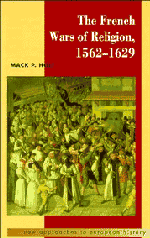Book contents
- Frontmatter
- Contents
- List of maps and figures
- Chronological table of events
- Introduction
- 1 Prologue: Gallicanism and reform in the sixteenth century
- 2 ‘The beginning of a tragedy’: the early wars of religion, 1562–1570
- 3 Popular disorder and religious tensions: the making of a massacre, 1570–1574
- 4 The rhetoric of resistance: the unmaking of the body politic, 1574–1584
- 5 ‘Godly warriors’: the crisis of the League, 1584–1593
- 6 Henry IV and the Edict of Nantes: the remaking of Gallicanism, 1593–1610
- 7 Epilogue: the last war of religion, 1610–1629
- 8 Conclusions: economic impact, social change, and absolutism
- Genealogical charts
- Brief biographies
- Suggestions for further reading
- Index
4 - The rhetoric of resistance: the unmaking of the body politic, 1574–1584
Published online by Cambridge University Press: 05 June 2012
- Frontmatter
- Contents
- List of maps and figures
- Chronological table of events
- Introduction
- 1 Prologue: Gallicanism and reform in the sixteenth century
- 2 ‘The beginning of a tragedy’: the early wars of religion, 1562–1570
- 3 Popular disorder and religious tensions: the making of a massacre, 1570–1574
- 4 The rhetoric of resistance: the unmaking of the body politic, 1574–1584
- 5 ‘Godly warriors’: the crisis of the League, 1584–1593
- 6 Henry IV and the Edict of Nantes: the remaking of Gallicanism, 1593–1610
- 7 Epilogue: the last war of religion, 1610–1629
- 8 Conclusions: economic impact, social change, and absolutism
- Genealogical charts
- Brief biographies
- Suggestions for further reading
- Index
Summary
Although the St Bartholomew's massacres dealt a devasting blow to the Protestant movement in France, the violence far from exterminated the Huguenots. They were still protected under the law after the Peace of La Rochelle, though they were much more alienated from the crown than before the massacres, and the peace edict included no general toleration clause. This further polarization of Protestants and Catholics was nowhere more evident than in the post-massacre political manoeuvrings of the few remaining Huguenot leaders. With Jeanne d'Albret, Louis of Nassau, and Gaspard de Coligny all dead, and Henry of Navarre forced to convert to Catholicism in August 1572, only the young son of Condé – Henry de Bourbon, prince of Condé – remained among the national leaders, and he had also been forced to convert at the time of the massacres. This put all the more responsibility on the local Huguenot leaders in the south of France, especially Languedoc, where their remaining numbers were strongest. That they should decide to try to link the remaining fortified towns still in Huguenot hands together in a defensive alliance was unsurprising after the massacres. The decision to form a Huguenot republican constitution, however, was more radical.
Though we do not know its author, who subscribed to it, or even if it was ever implemented, such a constitution emerged in late 1572, and it was decidedly anti-monarchical.
- Type
- Chapter
- Information
- The French Wars of Religion, 1562–1629 , pp. 98 - 120Publisher: Cambridge University PressPrint publication year: 1995

